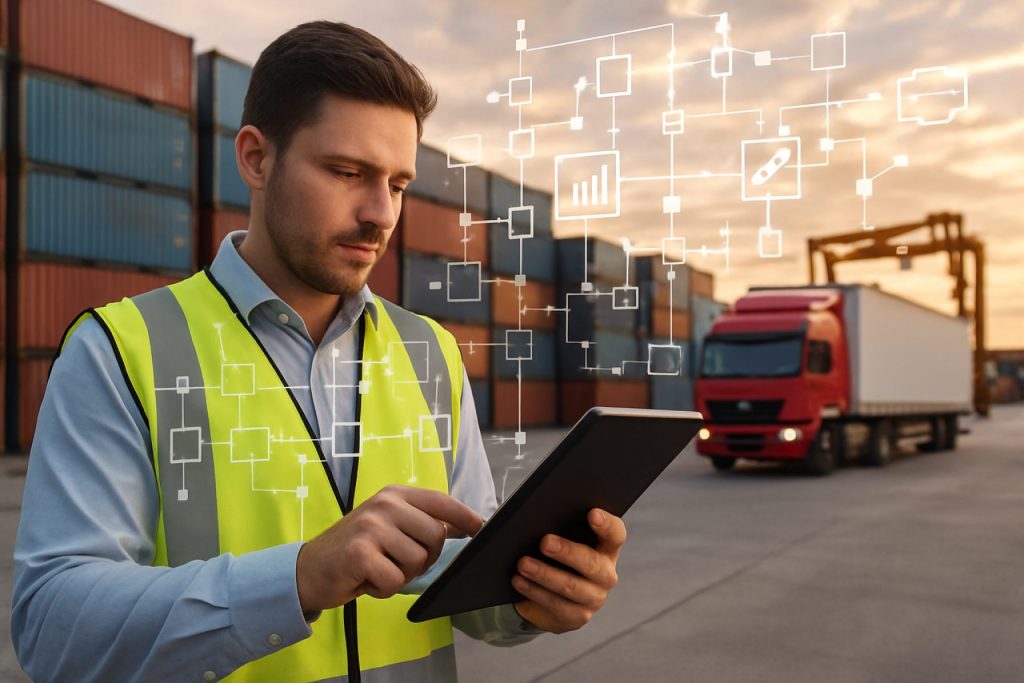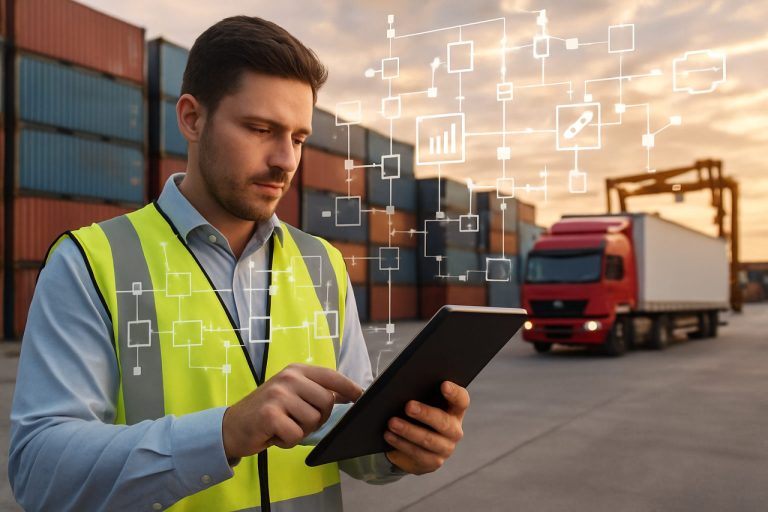
Blockchain-Powered Logistics Platforms Market Report 2025: In-Depth Analysis of Growth Drivers, Technology Innovations, and Global Adoption Trends. Explore Key Players, Forecasts, and Strategic Opportunities Shaping the Next 5 Years.
- Executive Summary & Market Overview
- Key Technology Trends in Blockchain Logistics (2025–2030)
- Competitive Landscape: Leading Players & Emerging Innovators
- Market Growth Forecasts & Revenue Projections (2025–2030)
- Regional Analysis: Adoption & Investment Hotspots
- Challenges, Risks, and Regulatory Considerations
- Opportunities & Strategic Recommendations for Stakeholders
- Future Outlook: Evolution of Blockchain in Logistics
- Sources & References
Executive Summary & Market Overview
Blockchain-powered logistics platforms are transforming the global supply chain landscape by introducing transparency, traceability, and efficiency to traditionally fragmented logistics processes. These platforms leverage distributed ledger technology to securely record and share data among stakeholders, reducing fraud, errors, and administrative costs. As of 2025, the adoption of blockchain in logistics is accelerating, driven by the need for real-time visibility, regulatory compliance, and the growing complexity of global trade.
According to Gartner, worldwide spending on blockchain solutions is projected to surpass $19 billion in 2024, with logistics and supply chain management representing a significant share of this investment. The market for blockchain in logistics is expected to grow at a CAGR of over 40% through 2025, as reported by MarketsandMarkets. This growth is fueled by the increasing demand for secure, tamper-proof records of shipments, automated smart contracts, and improved collaboration across supply chain partners.
- Transparency and Traceability: Blockchain platforms enable end-to-end visibility of goods, from origin to destination, allowing stakeholders to verify the authenticity and status of shipments in real time. This is particularly valuable in industries such as pharmaceuticals, food, and luxury goods, where provenance and compliance are critical.
- Operational Efficiency: By automating processes through smart contracts and reducing paperwork, blockchain-powered logistics platforms streamline workflows, minimize delays, and lower operational costs. IBM and Maersk have demonstrated significant reductions in processing times and administrative overhead through their blockchain initiatives.
- Security and Trust: The immutable nature of blockchain records enhances data security and builds trust among participants, mitigating risks of data manipulation and counterfeiting.
Despite these advantages, challenges remain, including interoperability between platforms, scalability, and regulatory uncertainties. However, ongoing standardization efforts by organizations such as the GS1 and increasing collaboration among industry leaders are expected to address these barriers. As blockchain-powered logistics platforms mature, they are poised to become foundational to the next generation of global supply chains in 2025 and beyond.
Key Technology Trends in Blockchain Logistics (2025–2030)
In 2025, blockchain-powered logistics platforms are poised to become a cornerstone of digital transformation in the supply chain sector. These platforms leverage distributed ledger technology to create transparent, tamper-proof records of transactions, shipments, and documentation, addressing long-standing challenges such as data silos, fraud, and inefficiencies. The adoption of blockchain in logistics is accelerating, driven by the need for real-time visibility, regulatory compliance, and cost reduction.
One of the most significant trends is the integration of blockchain with Internet of Things (IoT) devices, enabling automated data capture and verification at every stage of the logistics process. For example, platforms like IBM Supply Chain Intelligence Suite and Oracle Blockchain Platform are being deployed to track goods from origin to destination, ensuring data integrity and reducing manual intervention. These solutions facilitate instant sharing of shipment status, customs documentation, and proof of delivery among all stakeholders, including shippers, carriers, and regulators.
Smart contracts are another key feature of blockchain-powered logistics platforms in 2025. These self-executing contracts automate payment releases, insurance claims, and compliance checks based on predefined conditions, significantly reducing administrative overhead and disputes. According to Gartner, over 30% of large logistics companies are expected to implement smart contract solutions by the end of 2025, up from less than 10% in 2022.
- Interoperability: Leading platforms are focusing on interoperability, allowing seamless data exchange across different blockchain networks and legacy systems. Initiatives like the Hyperledger project are driving standardization efforts to support cross-platform collaboration.
- Data Privacy: Advanced cryptographic techniques, such as zero-knowledge proofs, are being integrated to protect sensitive business information while maintaining transparency for audit purposes.
- Scalability: Solutions are increasingly leveraging Layer 2 protocols and sidechains to handle high transaction volumes without compromising speed or cost efficiency.
As blockchain-powered logistics platforms mature in 2025, industry leaders such as Maersk and DHL are expanding pilot programs into full-scale deployments, setting new benchmarks for transparency, traceability, and operational efficiency in global supply chains.
Competitive Landscape: Leading Players & Emerging Innovators
The competitive landscape for blockchain-powered logistics platforms in 2025 is characterized by a dynamic mix of established technology giants, specialized logistics solution providers, and a wave of innovative startups. These players are leveraging blockchain to address persistent industry challenges such as supply chain transparency, traceability, and operational efficiency.
Leading Players
- IBM remains a dominant force, with its IBM Blockchain Transparent Supply platform widely adopted by global logistics and shipping companies. IBM’s partnerships with major industry players, such as Maersk, have resulted in the TradeLens platform, which streamlines documentation and real-time cargo tracking.
- Oracle has expanded its blockchain applications for logistics, focusing on secure data sharing and automated compliance. Its solutions are integrated with existing enterprise resource planning (ERP) systems, making adoption seamless for large-scale logistics operators.
- SAP offers blockchain-as-a-service for supply chain management, enabling clients to build custom logistics solutions that enhance visibility and reduce fraud.
Emerging Innovators
- VeChain has gained traction with its blockchain platform tailored for supply chain and logistics, particularly in food safety and luxury goods. Its partnerships with logistics providers in Asia and Europe have demonstrated real-world scalability.
- Modum focuses on integrating IoT sensors with blockchain to ensure the integrity of temperature-sensitive shipments, serving pharmaceutical and perishable goods logistics.
- OriginTrail offers a decentralized knowledge graph for supply chains, enabling interoperability between different blockchain networks and legacy systems, which is crucial for complex, multi-party logistics operations.
According to Gartner, blockchain adoption in supply chain and logistics is projected to reach 30% by 2025, driven by the need for end-to-end visibility and regulatory compliance. The market is also witnessing increased collaboration between traditional logistics firms and blockchain startups, as seen in pilot projects and consortiums aimed at standardizing data exchange and smart contract protocols.
Overall, the competitive landscape in 2025 is marked by rapid innovation, strategic alliances, and a clear trend toward interoperability, positioning blockchain as a foundational technology for the next generation of logistics platforms.
Market Growth Forecasts & Revenue Projections (2025–2030)
The market for blockchain-powered logistics platforms is poised for robust growth in 2025, driven by increasing demand for transparency, traceability, and efficiency across global supply chains. According to projections by Gartner, the global blockchain for supply chain market is expected to reach approximately $4.2 billion in 2025, up from an estimated $2.7 billion in 2023, reflecting a compound annual growth rate (CAGR) of over 22%. This surge is attributed to accelerated adoption among logistics providers, manufacturers, and retailers seeking to mitigate fraud, reduce paperwork, and streamline cross-border operations.
Regionally, North America is anticipated to maintain its leadership position in 2025, accounting for nearly 38% of total market revenue, fueled by early adoption among major logistics firms and supportive regulatory frameworks. Europe and Asia-Pacific are also projected to experience significant growth, with Asia-Pacific’s CAGR outpacing other regions due to rapid digitalization and government initiatives in countries such as China, Singapore, and South Korea (IDC).
Key industry verticals driving revenue in 2025 include food and beverage, pharmaceuticals, and automotive logistics. The food and beverage sector, in particular, is leveraging blockchain to enhance end-to-end traceability and comply with stringent safety regulations, while the pharmaceutical industry is utilizing the technology to combat counterfeiting and ensure regulatory compliance (IBM).
- Revenue Streams: The primary revenue streams for blockchain-powered logistics platforms in 2025 are expected to come from software licensing, transaction fees, and value-added services such as real-time tracking and smart contract automation.
- Enterprise Adoption: Large-scale enterprises are projected to account for over 60% of platform revenues, as they invest in digital transformation to gain competitive advantages and meet evolving customer expectations.
- Startups & Innovation: The influx of venture capital into blockchain logistics startups is anticipated to further accelerate innovation and market expansion in 2025 (CB Insights).
Overall, 2025 is set to be a pivotal year for blockchain-powered logistics platforms, with revenue growth underpinned by technological advancements, regulatory support, and increasing enterprise adoption across key supply chain sectors.
Regional Analysis: Adoption & Investment Hotspots
In 2025, the adoption and investment landscape for blockchain-powered logistics platforms is marked by pronounced regional disparities, driven by regulatory environments, digital infrastructure maturity, and the strategic priorities of local industries. Asia-Pacific (APAC) continues to emerge as a global hotspot, with countries such as China, Singapore, and South Korea leading in both pilot projects and scaled deployments. China’s Belt and Road Initiative has catalyzed blockchain integration in cross-border logistics, with major players like Alibaba Group and JD.com investing heavily in blockchain-based supply chain traceability and customs clearance solutions. Singapore’s government-backed initiatives, such as the TradeTrust framework, further reinforce the city-state’s position as a regional blockchain logistics hub, attracting significant venture capital and multinational partnerships (Infocomm Media Development Authority).
In North America, the United States remains a leader in blockchain logistics innovation, propelled by a robust startup ecosystem and the active involvement of logistics giants like FedEx and IBM. Investment is concentrated in solutions that enhance transparency, automate documentation, and improve last-mile delivery efficiency. The U.S. market benefits from a favorable regulatory climate and strong collaboration between technology providers and logistics operators (Gartner). Canada is also making strides, particularly in the integration of blockchain with IoT for cold chain logistics, supported by government grants and public-private partnerships.
Europe’s adoption is characterized by a focus on sustainability and regulatory compliance, with the European Union’s digital strategy encouraging blockchain use for carbon tracking and customs harmonization. The Netherlands and Germany are at the forefront, leveraging their central roles in European trade. Initiatives like the Dutch Blockchain Coalition and the Port of Rotterdam’s blockchain pilots exemplify the region’s commitment to digitalizing logistics processes (Port of Rotterdam).
In the Middle East, the United Arab Emirates stands out, with Dubai’s government-led Blockchain Strategy driving adoption in port and customs operations. The Dubai Trade platform and partnerships with global technology firms have positioned the emirate as a regional leader (Dubai Trade).
Latin America and Africa are in earlier stages of adoption, but pilot projects in Brazil and South Africa signal growing interest, particularly in agricultural exports and anti-counterfeiting measures. Investment in these regions is expected to accelerate as digital infrastructure improves and regulatory frameworks mature (IDC).
Challenges, Risks, and Regulatory Considerations
Blockchain-powered logistics platforms are poised to transform supply chain management by enhancing transparency, traceability, and efficiency. However, as adoption accelerates in 2025, several challenges, risks, and regulatory considerations must be addressed to ensure sustainable growth and widespread implementation.
Technical and Integration Challenges
- Interoperability: Logistics networks often involve multiple stakeholders using disparate systems. Achieving seamless interoperability between legacy IT infrastructure and blockchain solutions remains a significant hurdle, as highlighted by Gartner.
- Scalability: As transaction volumes increase, public blockchains may face congestion and high transaction fees, potentially undermining the cost-effectiveness and speed advantages of blockchain-based logistics platforms (IDC).
- Data Quality: Blockchain’s immutability means that inaccurate or fraudulent data, once entered, cannot be easily corrected. Ensuring data integrity at the point of entry is a persistent challenge for logistics operators (Deloitte).
Risks
- Cybersecurity: While blockchain is inherently secure, endpoints and smart contracts can be vulnerable to cyberattacks. Exploits or breaches could compromise sensitive shipment or customer data (IBM).
- Vendor Lock-In: Proprietary blockchain solutions may create dependencies on specific technology providers, limiting flexibility and increasing long-term costs (PwC).
- Operational Disruption: Transitioning to blockchain-based systems can disrupt established workflows, requiring significant change management and staff retraining (Accenture).
Regulatory Considerations
- Data Privacy and Sovereignty: Compliance with data protection regulations such as the EU’s GDPR and China’s CSL is complex, especially when logistics data crosses borders and is stored on immutable ledgers (European Commission).
- Standardization: The lack of universally accepted standards for blockchain implementation in logistics creates uncertainty and hinders interoperability. Industry consortia, such as the BSI and ISO, are working to address this gap, but progress is gradual.
- Legal Recognition: The legal status of smart contracts and blockchain records varies by jurisdiction, affecting enforceability and dispute resolution in cross-border logistics operations (UNCTAD).
In summary, while blockchain-powered logistics platforms offer compelling benefits, overcoming technical, operational, and regulatory barriers will be critical for their mainstream adoption in 2025 and beyond.
Opportunities & Strategic Recommendations for Stakeholders
The evolution of blockchain-powered logistics platforms in 2025 presents a spectrum of opportunities for stakeholders across the supply chain, from shippers and carriers to technology providers and regulators. As the logistics sector grapples with persistent challenges—such as fragmented data, lack of transparency, and inefficiencies—blockchain’s decentralized ledger technology offers transformative potential for operational optimization and trust-building.
Opportunities:
- Enhanced Transparency and Traceability: Blockchain enables immutable, real-time tracking of goods, documents, and transactions. This transparency can significantly reduce fraud, counterfeiting, and disputes, especially in high-value or regulated industries such as pharmaceuticals and food logistics (IBM).
- Streamlined Documentation and Automation: Smart contracts can automate processes like payments, customs clearance, and compliance checks, reducing paperwork and administrative costs. This is particularly relevant for cross-border logistics, where manual processes often cause delays (Deloitte).
- Improved Collaboration and Data Sharing: Blockchain platforms facilitate secure, permissioned data sharing among stakeholders, fostering collaboration without compromising proprietary information. This can lead to more efficient route planning, inventory management, and demand forecasting (Gartner).
- New Business Models: The rise of decentralized logistics marketplaces and tokenized assets can unlock new revenue streams and participation models, such as pay-per-use logistics services or micro-incentives for data sharing (Accenture).
Strategic Recommendations:
- Invest in Pilot Projects: Stakeholders should prioritize pilot implementations to validate blockchain’s value in specific logistics processes, focusing on measurable KPIs such as cost savings, error reduction, and lead time improvements.
- Foster Ecosystem Partnerships: Collaboration with technology vendors, industry consortia, and regulatory bodies is essential to ensure interoperability, standardization, and compliance. Engaging with established platforms and alliances can accelerate adoption (Blockchain in Transport Alliance (BiTA)).
- Develop Talent and Change Management: Upskilling teams in blockchain technology and change management will be critical to drive internal adoption and maximize ROI.
- Monitor Regulatory Developments: Proactively track evolving data privacy, security, and cross-border trade regulations to ensure compliance and future-proof investments.
In summary, 2025 is poised to be a pivotal year for blockchain-powered logistics platforms, with early movers likely to gain significant competitive advantages through enhanced efficiency, trust, and innovation.
Future Outlook: Evolution of Blockchain in Logistics
By 2025, blockchain-powered logistics platforms are poised to transition from pilot projects to mainstream adoption, fundamentally reshaping supply chain management. These platforms leverage distributed ledger technology to provide real-time, immutable records of transactions, enhancing transparency, traceability, and trust among stakeholders. The evolution is driven by increasing demand for end-to-end visibility, regulatory compliance, and the need to mitigate risks such as fraud and counterfeiting.
Industry leaders are already investing heavily in blockchain integration. For example, IBM and Maersk have collaborated on TradeLens, a blockchain-based platform that streamlines documentation and improves data sharing across global shipping networks. Although TradeLens announced its discontinuation in late 2022, the lessons learned have spurred new initiatives and partnerships, with companies like Oracle and SAP offering blockchain-as-a-service solutions tailored for logistics.
According to Gartner, by 2025, 30% of manufacturing companies with more than $5 billion in revenue are expected to have implemented blockchain-enabled platforms for supply chain operations. These platforms are anticipated to facilitate automated payments, smart contracts, and real-time inventory management, reducing administrative overhead and accelerating transaction cycles.
Emerging trends include the integration of blockchain with IoT devices, enabling automated data capture and verification at every stage of the logistics process. This convergence is expected to further enhance the accuracy of shipment tracking and condition monitoring, as highlighted by DHL in its white paper on blockchain in logistics.
- Increased interoperability: Standardization efforts by organizations like GS1 are expected to enable seamless data exchange between disparate blockchain networks.
- Regulatory alignment: Governments and international bodies are developing frameworks to support blockchain adoption, ensuring compliance and data privacy.
- Scalability improvements: Advances in blockchain protocols are addressing transaction speed and cost, making large-scale deployment feasible.
In summary, by 2025, blockchain-powered logistics platforms are set to become integral to global supply chains, driving efficiency, security, and innovation across the logistics sector.
Sources & References
- MarketsandMarkets
- IBM
- Maersk
- GS1
- Oracle Blockchain Platform
- Hyperledger
- VeChain
- OriginTrail
- IDC
- Alibaba Group
- JD.com
- Infocomm Media Development Authority
- Port of Rotterdam
- Deloitte
- PwC
- Accenture
- European Commission
- ISO



